微喷灌结合滴灌对温室高温环境和作物生长生理特性的影响
张 川,张亨年,闫浩芳,Samuel Joe Acquah,邢德科
微喷灌结合滴灌对温室高温环境和作物生长生理特性的影响
张 川1,张亨年1,闫浩芳2,Samuel Joe Acquah2,邢德科1
(1. 江苏大学农业装备工程学院,镇江 212013; 2. 江苏大学流体机械工程技术研究中心,镇江 212013)
微喷灌结合滴灌是指在作物根区滴灌的基础上对作物冠层进行微喷灌来改善作物生长环境的一种灌水方式。为了探明微喷灌结合滴灌(micro-sprinkler irrigation combined with drip irrigation,MSDI)和地表滴灌(surface drip irrigation,SDI)2种灌水方式下温室高温环境及作物生长生理特性的差异及响应规律,该研究以黄瓜为试验对象,于2017年2-6月开展了2种灌水方式下温室环境及黄瓜生长生理特性的观测试验。结果表明:在改变温室环境方面,MSDI灌水方式较SDI可增加温室内相对湿度,降低气温,同时降低叶片温度约4℃;在作物生长生理特性方面,采用MSDI可增加黄瓜株高与茎粗,降低作物茎流速率,促进黄瓜生长;2种灌水方式下黄瓜最大光合效率几乎一致,分别为0.74和0.77,但日平均实际光合效率差异明显,分别为0.57和0.47,MSDI灌水方式下黄瓜叶片日平均气孔导度和光合速率比SDI方式分别高182.8%和92.4%。该研究成果对于合理调控温室高温环境、提高温室作物产量具有重要的指导意义。
灌溉;温室;作物;微喷灌;地表滴灌;茎流速率;光合速率;光合效率
0 引 言
在人口增长和环境变化对传统种植业的冲击下,发展设施农业势在必行,中国设施面积目前超过400万hm2,是世界上设施栽培面积最大的国家[1-2]。主流温室在设计和建造的过程中更多地强调了采光、蓄热和保温,因此,温室内极易形成高温环境[3],特别是在南方夏季高温地区,温室内气温常达40 ℃以上,许多大型温室在7-9月份的高温季节处于“停产”状态,严重影响了温室的利用效率,夏季温室的降温问题成为困扰现代大型温室发展和应用的技术难题[4]。目前主要采用遮阳和湿帘风机系统两种方法进行降温,但是,在遮阳降温的同时,也降低了光照强度,缩短了有效光合时间,影响蔬菜的生长发育和光合作用,如果遮阴时间过长,会严重影响果类蔬菜的开花坐果和产量的形成[5];湿帘-风机降温系统虽然在中国北方地区有较好的效果,但该系统在潮湿的南方地区应用效果并不理想[6],并且在运行过程中存在能耗较高等问题[7]。
目前,科学合理的灌水方式逐渐成为改善作物生长环境和提高作物光合效率的重要手段,对于促进农业可持续发展具有重要意义[8-10],而微喷灌和滴灌作为设施农业中较为先进的2种灌水方式,受到较多学者的关注和研究[11-12]。刘海军等[13-14]研究表明微喷灌可降低作物冠层周围的温度,改善作物生长环境,从而缩短作物叶片在高温的中午发生光合“午休”现象的时间,实现作物快速生长[15-17],但仅采用微喷灌进行灌溉往往会造成温室持续处于高湿的状态,作物易受病菌感染[18]。滴灌因其不发生土壤深层渗漏和土壤表层溢水,较其他灌水方式可节约用水50%以上[19],Hebbar等[20-21]发现滴灌能显著增加作物干物质积累,有利于作物的生长发育,但对于改善作物生长环境较为有限,难以解决夏季温室高温危害作物生长的问题。
因此,本研究以黄瓜为研究对象开展温室试验,通过观测及对比分析微喷灌结合滴灌和地表滴灌2种灌溉方式下的温室气象环境(空气温度、相对湿度和叶温)及黄瓜生长生理特性(株高、茎粗、茎流速率和光合速率等)的变化规律及差异,探讨微喷灌结合滴灌对温室高温环境及黄瓜生长生理特性的影响机制。该研究成果不仅可以作为指导温室黄瓜准确灌溉的依据,而且对于实现温室高温环境的合理调控具有重要意义。
1 材料与方法
1.1 试验区概况
试验于2017年2-6月在江苏大学Venlo型玻璃温室内进行,试验地位于江苏省镇江市(32°11′N、119°25′E,海拔23 m),温室屋脊南北走向,长20 m,天沟高3.8 m,檐高4.4 m,跨度6.4 m,共两跨,每跨2个小屋顶,覆盖材料为4 mm厚的浮法玻璃,东北两侧设有侧窗,高温时开窗通风。土壤容重为1.35 g/cm3,表层土壤田间持水率为41.1%,土壤孔隙度为57.9%。
1.2 试验设计
供试黄瓜为密刺黄瓜,品种为油亮3-2,采用土槽种植,土槽长65 cm,宽45 cm,深30 cm,南北走向,土槽四周均用水泥浇筑。试验期为2017年2月21日-6月29日。黄瓜于2017年2月21日播种,4月6日移栽,移栽前施复合肥料(高浓度硫酸钾型)作为底肥,种植密度为3.3株/m2。黄瓜生育期分为:苗期(4月6日-5月5日)、开花坐果期(5月6日-5月22日)及成熟采摘期(5月23日-6月29日)。试验设置微喷灌结合滴灌(micro-sprinkler irrigation combined with drip irrigation,MSDI)和地表滴灌(surface drip irrigation,SDI)2种灌水方式,其中MSDI灌水方式是指在SDI基础上结合倒挂式作物冠层微喷灌(喷头与土槽一一对应,倒立悬挂于土槽上方,高2 m),每种灌水方式设置8个土槽作为重复。苗期由于温室内气温适宜黄瓜生长,暂未开启微喷灌,2种灌水方式均只采用滴灌进行灌水,灌水时间为每天早晨06:00,滴头流量为140 mL/min,每株灌水5 min。5月6日黄瓜进入开花坐果期,温室内最高温度达到33℃,为降低作物冠层周围空气温度和叶片温度,提供适宜的生长环境,MSDI灌水方式为在滴灌的基础上开启微喷灌(阴雨天关闭),微喷灌时间为每日09:00、10:00、11:00和12:00,每次持续2 min。
1.3 试验观测项目
1.3.1 气象数据
温室中安装一套自动气象监测系统,该系统包括温湿度传感器(HMP45C,Campbell)、太阳净辐射仪(NR Lite2,Kipp&Zonen,Netherlands)、全球太阳短波辐射表(Decagon,USA)、长波辐射表(PRI-01,Prede,Japan)和风速仪(Wind Sonic,Gill)。所有数据均由CR1000数据采集系统(Campbell,USA)每10 min自动采集。另外,在作物冠层不同高度安装3个温湿度传感器(U23-002,HOBO),安装高度分别为0.8、1.3和1.8 m,探头朝南,精度为±0.1 ℃。
1.3.2 株高及茎粗
每种灌水方式随机挑选10株长势良好无病害的植株进行标记,分别在黄瓜苗期、开花坐果期和成熟采摘期进行株高和茎粗的测定。株高采用直尺测量茎基部到茎尖端的高度,茎粗采用游标卡尺测量茎秆基部的直径。
1.3.3 蒸腾速率
测定植株茎秆液流是获取作物蒸腾速率的有效方法之一[22],采用包裹式茎流计(Flow32-1k system,Dynamax,USA)在黄瓜成熟采摘期内(6月12-18日)测定植株茎秆液流速率。每种灌水方式随机挑选2株长势良好无病害的植株,茎流计安装在第5枝节,避免土壤热反射的干扰。所选茎流计规格均满足黄瓜茎秆直径要求,确保茎流计与茎秆紧密接触,设置CR1000数据采集器(Campbell,USA)每30 min自动采集数据。
1.3.4 叶绿素荧光及叶片温度
本研究采用多通道调制荧光仪Monitoring-PAM(WALZ,Germany)在黄瓜成熟采摘期内(6月12-18日)连续监测植株的荧光参数和叶片温度。每种灌水方式随机挑选2株长势良好无病害的植株,选取旗叶以下第5片功能叶,在自然光照条件下,测定实际光合效率(II),设置MONI-DA数据采集器每10 min自动采集数据。
1.3.5 光合速率
试验采用GFS-3000便携式光合测量仪(WALZ,Germany),在黄瓜成熟采摘期内选择晴朗无云日测定叶片光合速率(photosynthetic rate)和气孔导度(stomatal conductance)。每种灌水方式随机挑选3株长势良好无病害的植株,选取旗叶以下第5片功能叶测定其中部位置,每片叶片测量3次取平均值,观测时间为08:00-18:00之间,每隔1.5~2 h测定一次。
2 结果与分析
2.1 MSDI灌水方式对温室高温环境及黄瓜叶片温度的影响
本研究对温室高温环境进行连续监测,结果显示不同日期空气温度和相对湿度的变化规律相似,因此以6月15日实测数据为例进行分析。MSDI灌水方式下温室高温环境变化规律如图1所示,包括不同高度的冠层温度(图1a)和相对湿度(图1b),夜间(18:00至次日06:00)不同高度(0.8、1.3和1.8 m)冠层温湿度基本相同,之后随太阳辐射增强,冠层间温湿度开始产生差异,1.8 m处温度最高,相对湿度最低,0.8 m处温度最低,相对湿度最高,1.3 m处温湿度均处于中间水平。在间断开启微喷灌后(如图中箭头所示),不同高度的冠层温度均比下降,湿度均比增加,不同高度温湿度变化规律相似,1.8 m处距离喷头最近,温湿度变化幅度大于0.8 m和1.3 m处。
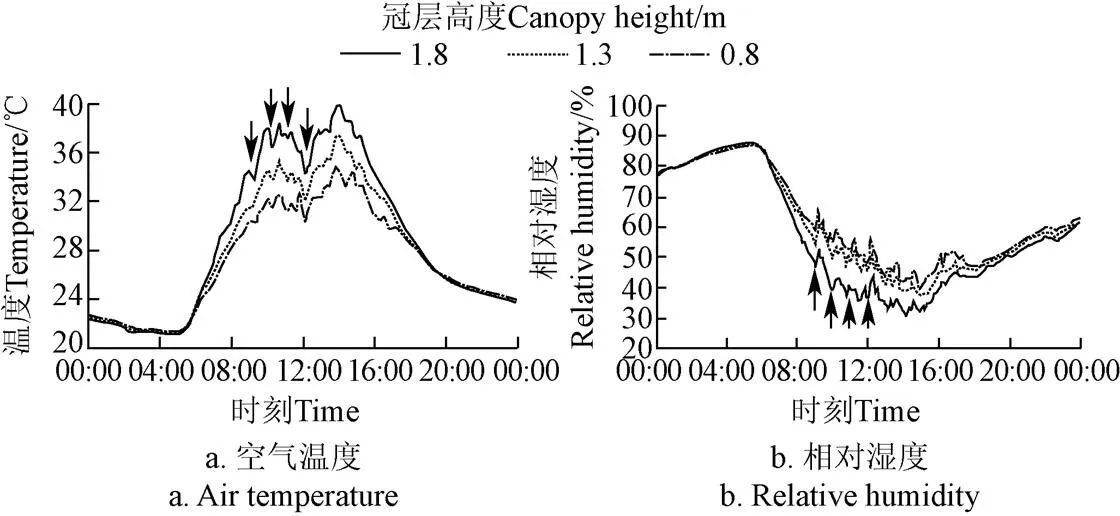
注:图中箭头为开启微喷灌时刻,MSDI 为微喷灌结合滴灌的灌水方式,下同。
2种灌水方式黄瓜叶片温度日变化规律如图2所示,未开启微喷灌时段内,2种灌水方式叶片温度基本相同。MSDI灌水方式在不同时刻开启微喷灌后,叶片温度较SDI方式下降约4 ℃,每次下降持续时间约10 min。停止微喷灌后约1~2 h,MSDI灌水方式下叶片温度恢复到SDI灌水方式下叶温水平。
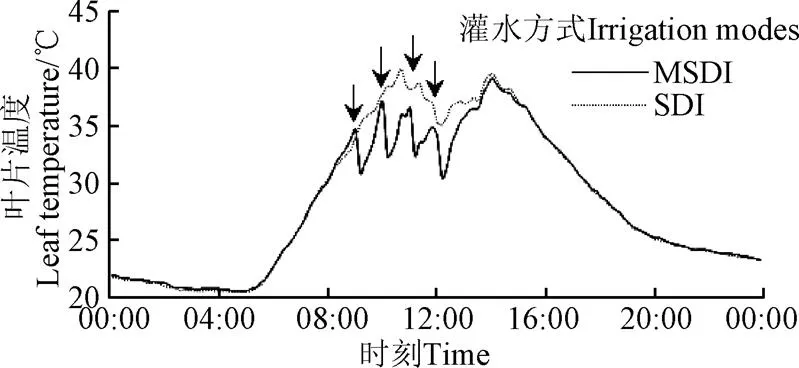
注:SDI 为地表滴灌的灌水方式。
2.2 2种灌水方式下黄瓜株高茎粗的变化
株高和茎粗反映不同生育时期作物的生长状态[23-24]。2种灌水方式下黄瓜株高和茎粗的变化规律如图3所示。苗期(4月6日-5月5日)未开启微喷灌时,2种灌水方式下株高和茎粗基本相同。进入开花坐果期(5月6日)开启微喷灌,5月8日对株高进行观测,MSDI灌水方式下作物株高较SDI灌水方式显著提高了22.5%(<0.05),随着黄瓜的生长,MSDI灌水方式下黄瓜平均株高高于SDI灌水方式。由于黄瓜茎粗增长有限,整个生育期内2种灌水方式下黄瓜茎粗差异不显著,MSDI相比SDI灌水方式可促进黄瓜更好的生长,促进作物干物质的形成。
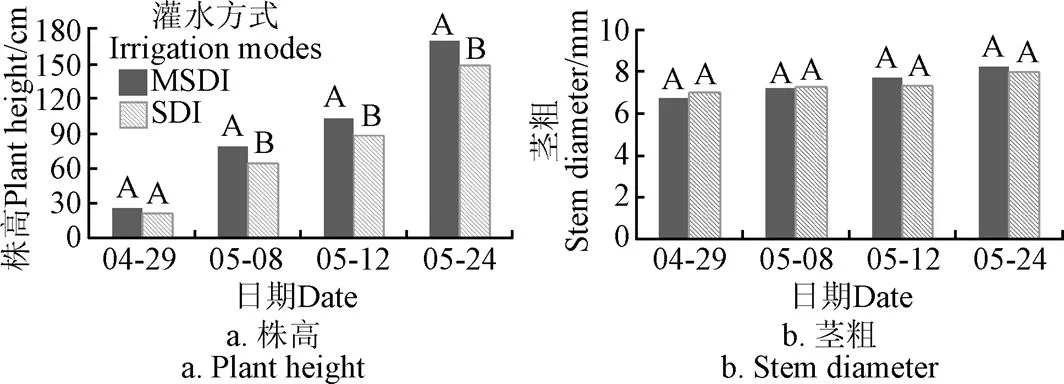
注:不同大写字母表示2种灌水方式在0.05水平上差异显著。
2.3 2种灌水方式下黄瓜植株茎流速率的变化规律
选取黄瓜对水分敏感的成熟采摘期的茎流速率平均值进行对比分析。从图4中可以看出,2种灌水方式下黄瓜茎流速率的日变化趋势相似,都呈先增大,后减小的趋势,但在MSDI灌水方式下,当开启微喷灌后茎流速率下降明显,每次持续下降约30 min,整个观测时段内MSDI灌水方式下植株茎流速率始终高于SDI方式,其原因可能是MSDI灌水方式所选植株茎粗(6.55 mm)比SDI 灌水方式所选植株茎粗(5.97 mm)较大,植株长势更好,造成茎流速率变大。

图4 2种灌水方式下黄瓜茎流速率日变化规律
夏季高温时时段,为防止茎流速率过大所导致的叶片失水严重,作物将关闭部分气孔进行自我保护。茎流速率除受到气孔导度等内因的影响,还受气象因子等外因影响,不同气象因子对茎流速率的影响程度不同,2种灌水方式下黄瓜茎流速率与气象因子的相关性分析如表1所示。

表1 温室环境2种灌水方式下黄瓜茎流速率与气象因子的相关性分析
注:**分别表示在0.01 水平上显著相关,=33;T为空气温度;RH为空气相对湿度;SR为太阳辐射;R为太阳净辐射。
Note: ** represents significantly correlated at 0.01 level, respectively,=33;Tis air temperature; RH is relative humidity; SR is solar radiation;Ris net radiation .
在MSDI和SDI灌水方式下,黄瓜茎流速率与温室内气象因子具有很高的相关性,其中茎流速率与空气温度(T)、太阳辐射(SR)和净辐射(R)呈极显著正相关(<0.01),与相对湿度(RH)呈极显著负相关(<0.01),表明T、SR、R和RH是影响黄瓜茎流速率的主要因素。进一步对植株茎流速率与温室气象因子进行回归分析,结果如表2所示。

表2 2种灌水方式下黄瓜茎流速率与气象因子逐步回归分析
经检验,回归模型显著性水平均小于0.01,其中,净辐射(R)和气温(T)在MSDI和SDI灌水方式下均入选回归方程,表明2种灌水方式下,R和T为影响黄瓜茎流速率的主要气象因子,二者与茎流速率的回归系数均为正值,茎流速率随R和T的增大而增大。彭致功等[25-26]认为净辐射(R)的影响作用最大,其次分别为RH和T,与本研究结果相似,其不同可能是本研究采用微喷改变了作物冠层周围的空气相对湿度所致。该结果表明采用MSDI灌水方式可通过降低T,增加RH,来减小黄瓜茎流速率。
2.4 2种灌水方式下黄瓜植株光合速率的变化规律
图5为2种灌水方式下黄瓜叶片气孔导度和光合速率的日变化规律。2种灌水方式下黄瓜叶片气孔导度均为先升高后降低的单峰型曲线,如图5a。MSDI灌水方式下叶片气孔导度在08:00-10:00急剧上升,而SDI灌水方式下上升较为缓慢,2种灌水方式叶片气孔导度均在10:00达到最大值,随后因温室内气温升高,作物为防止叶片失水严重,会关闭部分气孔进行自我保护,从而使得气孔导度迅速下降[27]。气孔的不均匀关闭降低了细胞间隙CO2浓度进而降低了植物的光合速率[28]。2种灌水方式下黄瓜叶片光合速率日变化规律如图5b所示,叶片光合速率与气孔导度变化规律相似,但略滞后于气孔导度。MSDI灌水方式对提高黄瓜叶片气孔导度和光合速率效果明显,日平均气孔导度和光合速率分别较SDI灌水方式提高了182.8%和92.4%。
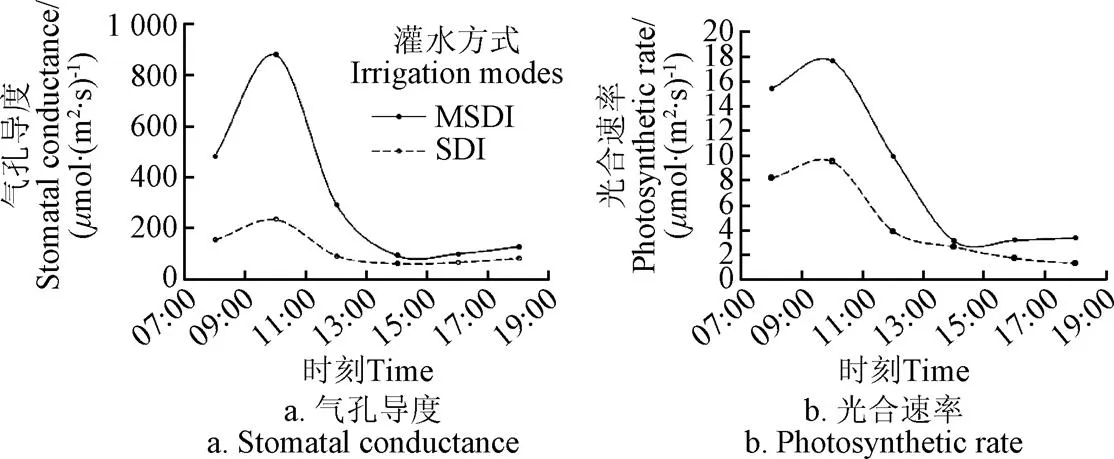
图5 2种灌水方式下黄瓜气孔导度和光合速率日变化
2.5 2种灌水方式下黄瓜植株叶绿素荧光的变化规律
夜间叶片处于黑暗环境,Monitoring PAM测得光系统II的最大光合效率,它反映了植株潜在最大光能转换效率,在植株未受到任何胁迫条件下该参数变化很小且不受物种的影响,一般为0.8左右[29];白天叶片吸收太阳辐射进行光合作用,此阶段测得光系统II的实际光合效率,反映了光合机构目前的实际光能转换效率[30]。
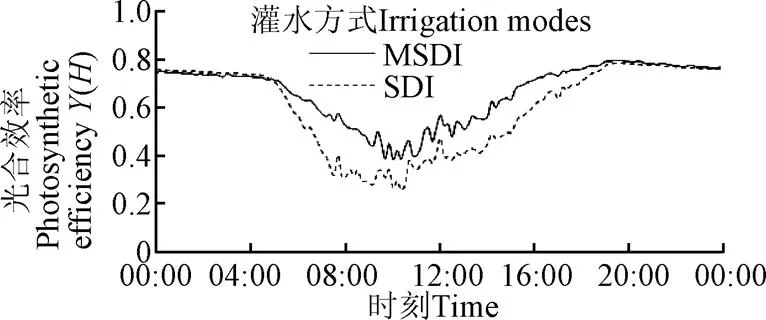
图6 2种灌水方式下黄瓜光系统Ⅱ光合效率的变化(2017-06-15)
从图6可以看出,MSDI和SDI灌水方式下夜间(19:00至次日05:00)叶片最大光合效率分别约为0.74和0.77,2种灌水方式下叶片最大光合效率几乎一致,接近正常值0.8,表明2种灌水方式下的叶片均没有受到不可逆的高温损害[29]。光系统II的实际光合效率在白天(05:00至19:00)迅速下降,在中午温室内高温时达到最低值。MSDI灌水方式下叶片实际光能转换效率明显大于SDI方式,MSDI灌水方式下黄瓜叶片日平均实际光合效率为0.57,SDI灌水方式下黄瓜叶片日平均实际光合效率为0.47,采用MSDI灌水方式可缓解温室高温对光系统II实际光能转换效率的胁迫,改善叶肉细胞的光合能力。
3 讨 论
黄瓜最适生长温度为昼温25 ℃,夜温15 ℃,40 ℃以上高温会引起作物萎蔫,50 ℃高温会使作物枯萎[31]。夏季中午光照强,温室内易形成高温环境,气温常达到40 ℃以上,这一生长环境不利于黄瓜正常生长,在温室高温环境时,利用MSDI灌水方式调节温室作物冠层高温环境,降低气温,增加相对湿度,对于促进黄瓜生长效果明显,其结果直接体现在黄瓜株高和茎粗上。有研究表明,当温室内相对湿度持续高于80%~90%易产生病虫害,造成作物减产等相关问题[32-33]。本研究结果显示,温室内夜间相对湿度最高且较为稳定,白天随着太阳辐射的增强,相对湿度逐渐降低,于15:00点左右达到最低值,MSDI灌水方式开启微喷灌时,温室内相对湿度约45%~65%,开启微喷灌后,相对湿度均比最大增幅约6%,微喷灌仅小幅提升了每日最低相对湿度,并不会造成温室持续高湿环境。
光照过强、叶温过高、水汽压亏缺造成作物光合速率的下降,其中相对湿度的降低,部分气孔关闭是导致光合速率降低的主要生态、生理因子[34]。本研究结果显示,温室内气温和叶温达到全天最高值,相对湿度降至最低时,作物光合速率最低,且叶片气孔导度处于最低的水平,造成气孔部分关闭的原因是作物蒸腾速率过高,由于温湿度是影响作物蒸腾速率的重要因素,因此,通过调节温室内温度和湿度可以降低作物蒸腾速率,减少气孔关闭程度,进而减小其对作物光合速率的抑制。
叶绿素荧光可以从本质上反映作物光合作用过程的变化,高温处理的叶片中由于CO2同化能力下降,造成对叶绿体中三磷酸腺苷(ATP)的需求减少,引起过剩光能增加,导致最大光合效率和实际光合效率明显降低[35-36],同时,李建建等[37]研究表明42℃/27℃(昼/夜温度)高温胁迫下会导致光系统II结构在短期内不可恢复的伤害。本研究结果显示,由于MSDI灌水方式可降低叶温约4 ℃,叶片受高温影响较小,该灌水方式光系统II的实际光转换效率明显高于SDI灌水方式。
综上所述,MSDI灌水方式较SDI可降低温室内气温,增加最低相对湿度,同时降低叶片温度约4 ℃。此外,采用MSDI灌水方式可促进黄瓜生长,降低植株茎流速率,明显提高日平均实际光合效率,其中,黄瓜叶片日平均气孔导度和光合速率较SDI灌水方式下提高了182.8%和92.4%。
4 结 论
通过对比分析微喷灌结合滴灌(micro-sprinkler irrigation combined with drip irrigation,MSDI)和地表滴灌(surface drip irrigation,SDI)对温室高温环境及黄瓜生长生理特性方面的影响,得到以下结论:
1)采用MSDI灌水方式可增加温室内相对湿度,降低气温,改善温室高温环境,同时可降低叶片温度约4℃。
2)通过温室内气象因子与植株茎流速率的相关性分析及逐步回归分析表明,净辐射和气温是影响植株茎流速率的主要气象因子,MSDI灌水方式通过降低气温,增加空气相对湿度,使植株茎流速率下降。
3)MSDI灌水方式有效提高了黄瓜叶片气孔导度和光合速率,日平均气孔导度和光合速率分别较SDI灌水方式高182.8%和92.4%。
4)2种灌水方式夜间叶片最大光合效率几乎一致,约为0.77,白天实际光能转换效率MSDI灌水方式为0.57,SDI方式0.47。利用MSDI灌水方式可提高叶片实际光能转换效率,改善叶肉细胞的光合能力。
[1] 李中华,王国占,齐飞,等. 我国设施农业发展现状及发展思路[J]. 中国农机化,2012(1):7-10.
Li Zhonghua, Wang Guozhan, Qi Fei. Current situation and thinking of development of protected agriculture in China[J]. Chinese Agricultural Mechanization, 2012(1): 7-10. (in Chinese with English abstract)
[2] 王新坤,李红. 我国温室的研究现状与发展趋势[J]. 排灌机械工程学报,2010,28(2):179-184.
Wang Xinkun, Li Hong. Current research status and development trend of greenhouse in China[J]. Journal of Drainage and Irrigation Machinery Engineering, 2010, 28(2): 179-184. (in Chinese with Englishabstract)
[3] 孙维拓,陈晓丽,杨其长,等. 水墙封闭温室夏季降温特性[J]. 农业工程学报,2016,32(8):162-170.
Sun Weituo, Chen Xiaoli, Yang Qichang, et al. Cooling characteristics of closed greenhouse with water-walls in summer[J]. Transactions of the Chinese Society Agricultural Engineering (Transactions of the CSAE), 2016, 32(8): 162-170. (in Chinese with English abstract)
[4] 陈传艳,赵纯清,张继元,等. 温室吸湿剂喷淋除湿降温系统的影响因子分析[J]. 农业工程学报,2012,28(10):202-207.
Chen Chuanyan, Zhao Chunqing, Zhang Jiyuan, et al. Anaysis of influencing factors of dehumidifying and cooling system with moisture absorbent spraying for greenhouse[J]. Transactions of the Chinese Society of Agricultural Engineering (Transactions of the CSAE), 2012, 28(10): 202-207. (in Chinese with English abstract)
[5] 王玉彦,党选民,朱国鹏. 南方温室不同时段遮阳降温效果及对甜椒生长发育和产量的影响[J]. 农业工程学报,2005(增刊2):64-66.
Wang Yuyan, Dang Xuanmin, Zhu Guopeng, et al.Sunshading and cooling effects of southern greenhouse under different periods and its influences on growth, development and yield of the sweet pepper[J]. Transactions of the Chinese Society of Agricultural Engineering (Transactions of the CSAE), 2005 (Suppl.2): 64-66. (in Chinese with English abstract)
[6] 刘佳,崔涛,王朝栋,等. 连栋温室夏季降温技术研究[J]. 农机化研究,2018,40(2):262-268.
Liu Jia, Cui Tao, Wang Chaodong, et al. Cooling technology of multi-span greenhousein summer[J]. Journal of Agricultural Mechanization Research, 2018, 40(2): 262-268. (in Chinese with English abstract)
[7] 赵杰强,赵云,吴伟雄. 塑料温室中湿帘风机通风条件下降温效果研究[J]. 农业工程,2012,2(10):13-15.
Zhao Jieqiang, Zhao Yun, Wu Weixiong. Cooling effects with fan pad ventilated in plastic greenhouse[J]. Agricultural Engineering, 2012, 2(10): 13-15. (in Chinese with English abstract)
[8] Lebourgeois V, Chopart J L, Begue A, et al. Towards using a thermal infrared index combined with water balance modelling to monitor sugarcane irrigation in a tropical environment[J]. Agricultural Water Management, 2010, 97: 75-82.
[9] 赵黎明,李明,郑殿峰,等. 灌水方式与种植密度对寒地水稻产量及光合物质生产特性的影响[J]. 农业工程学报,2015,31(6):159-169.
Zhao Liming, Li Ming, Zheng Dianfeng, et al. Effects of irrigation methods and rice planting densities on yield and photosynthetic characteristics of matter production in cold area[J]. Transactions of the Chinese Society of Agricultural Engineering (Transactions of the CSAE), 2015, 31(6): 159-169. (in Chinese with English abstract)
[10] Ravikumar V, Vijayakumar G, Simunekd J, et al. Evaluation of fertigation scheduling for sugarcane using a vadose zone flow and transport model[J]. Agricultural Water Management, 2011, 98: 1431-1440.
[11] 孔清华,李光永,王永红,等. 地下滴灌施氮及灌水周期对青椒根系分布及产量的影响[J]. 农业工程学报,2009,25(增刊2):38-42.
Kong Qinghua, Li Guangyong, Wang Yonghong, et al. Effects of nitrogen application and irrigation cycle on bell pepper root distribution and yield under subsurface drip irrigation[J]. Transactions of the Chinese Society of Agricultural Engineering (Transactions of the CSAE), 2009, 25(Suppl.2): 38-42. (in Chinese with English abstract)
[12] 张航,李久生. 华北平原春玉米生长和产量对滴灌均匀系数及灌水量的响应[J]. 农业工程学报,2011,27(11):176-182.
Zhang Hang, Li Jiusheng. Response of growth and yield of spring corn to drip irrigation uniformity and amount in North China Plain[J]. Transactions of the Chinese Society of Agricultural Engineering (Transactions of the CSAE), 2011, 27(11): 176-182. (in Chinese with English abstract)
[13] 刘海军,康跃虎,刘士平. 喷灌对冬小麦生长环境的调节及其对水分利用效率影响的研究[J]. 农业工程学报,2003,19(6):46-51.
Liu Haijun, Kang Yuehu, Liu Shiping. Regulation of field environmental condition by sprinkler irrigation and its effect on water use efficiency of winter wheat[J]. Transactions of the Chinese Society of Agricultural Engineering (Transactions of the CSAE), 2003, 19(6): 46-51. (in Chinese with English abstract)
[14] 杜尧东,王建,刘作新,等. 春小麦田喷灌的水量分布及小气候效应[J]. 应用生态学报,2001,12(3): 398-400.
Du Yaodong, Wang Jian, Liu Zuoxin, et al. Water distribution and microclimatic effects of sprinkler irrigation on spring wheat field[J]. Chinese Journal of Applied Ecology, 2001, 12(3): 398-400. (in Chinese with English abstract)
[15] 杨晓光,陈阜,宫飞,等. 喷灌条件下冬小麦生理特征及生态环境特点的试验研究[J]. 农业工程学报,2000,16(3):35-37. Yang Xiaoguang, Chen Fu, Gong Fei, et al. Physiological and ecological characteristics of winter wheat on the condition of sprinkle irrigation[J]. Transactions of the Chinese Society of Agricultural Engineering (Transactions of the CSAE), 2000, 16(3): 35-37. (in Chinese with English abstract)
[16] Tolk J A, Howell T A, Steiner J L, et al. Role of transpiration suppression by evaporation of intercepted water in improving irrigation efficiency[J]. Irrigation Science, 1995, 16(2):89-95.
[17] Salmeron M, Urrego Y F, Isla R. Effect of non-uniform sprinkler irrigation and plant density on simulated maize yield[J]. Agricultural Water Management, 2012, 113: 1-9.
[18] 赵淑梅,山口智治,周清,等. 现代温室湿帘风机降温系统的研究[J]. 农机化研究,2007(9):147-152.
Zhao Shumei, Tomoharu Yaguchi, Zhou Qing, et al. Study on pad and fan cooling system in modern greenhouse[J]. Journal of Agricultural Mechanization Research, 2007(9): 147-152. (in Chinese with English abstract)
[19] 覃建美,余宝泉,陈全有. 节水灌溉系统在温室花卉生产上的应用研究[J]. 现代农业科技,2007(16):14-16.
Tan Jianmei, Yu Baoquan, Chen Quanyou. Application of water saving irrigation system in flower production in greenhouse[J]. Modern Agricultural Science and Technology, 2007(16): 14-16. (in Chinese with English abstract)
[20] Hebbar S S, Ramachandrappa B K, Nanjappa H V, et al. Studies on NPK drip fertigation in field growntomato (Lycopersicon esculentum Mill.)[J]. European Journal of Agronomy, 2004, 21(1): 117-127.
[21] 郭文忠,陈青云,高丽红,等. 设施蔬菜生产节水灌溉制度研究现状及发展趋势[J]. 农业工程学报,2005,21(增刊2):24-27.
Guo Wenzhong, Chen Qingyun, Gao Lihong, et al. Present situation and developmental tendency on system of water-saving irrigation of vegetable production in protective cultivation[J]. Transactions of the Chinese Society of Agricultural Engineering (Transactions of the CSAE), 2005, 21(Suppl 2): 24-27. (in Chinese with English abstract)
[22] 刘安,刘旭,黄岚,等. 基于热平衡法检测植物茎流传感器的标定[J]. 农业工程学报,2010,26(增刊2):6-10.
Liu An, Liu Xu, Huang Lan, et al. A calibration method for stem-flow sensor based on heat balance[J]. Transactions of the Chinese Society of Agricultural Engineering (Transactions of the CSAE), 2010, 26(Supp.2): 6-10. (in Chinese with English abstract)
[23] 申宝营,李毅念,赵三琴,等. 暗期补光对黄瓜幼苗形态调节效果及综合评价[J]. 农业工程学报,2014,30(22):201-208.
Shen Baoying, Li Yinian, Zhao Sanqin, et al. Effect of dark period lighting regulation on cucumber seedling morphology and comprehensive evaluation analysis and comprehensive evaluation[J]. Transactions of the Chinese Society of Agricultural Engineering (Transactions of the CSAE), 2014, 30(22): 201-208. (in Chinese with English abstract)
[24] 费良军,汪爱科,王龙飞,等. 日光温室基质栽培樱桃西 红柿滴灌试验研究[J]. 排灌机械工程学报,2016,34(12):1070-1076.
Fei Liangjun, Wang Aike, Wang Longfei, et al. Experiment on substrate cultivation of cherry tomatoes in sunlight greenhouse with drip irrigation[J]. Journal of Drainage and Irrigation Machinery Engineering, 2016, 34(12): 1070-1076. (in Chinese with English abstract)
[25] 彭致功,段爱旺,刘祖贵,等. 日光温室条件下茄子植株蒸腾规律的研究[J]. 灌溉排水,2002,21(2):47-50.
Peng Zhigong, Duan Aiwang, Liu Gugui, et al. Research on plant transpiration in eggplant in solar-heated greenhouse[J]. Journal of Irrigation and Drainage, 2002, 21(2): 47-50. (in Chinese with English abstract)
[26] 龚雪文,刘浩,孙景生,等. 日光温室番茄不同空间尺度蒸散量变化及主控因子分析[J]. 农业工程学报,2017,33(8):166-175.
Gong Xuewen, Liu Hao, Sun Jingsheng, et al. Variation of evapotranspiration in different spatial scales for solar greenhouse tomato and its controlling meteorological factors[J]. Transactions of the Chinese Society of Agricultural Engineering (Transactions of the CSAE), 2017, 33(8): 166-175. (in Chinese with English abstract)
[27] Zhang Baozhong, Xu Di, Liu Yu, et al. Multi-scale evapotranspiration of summer maize and the controlling meteorological factors in north China[J]. Agricultural and Forest Meteorology, 2016, 216(5): 1-12.
[28] Franks P J, Farqnhar G D. The mechanical diversity of stomata and its significance in gas-exchange control[J]. Plant Physiology, 2007, 143(1): 78-87.
[29] 林琭,汤昀,张纪涛,等. 不同水势对黄瓜花后叶片气体交换及叶绿素荧光参数的影响[J]. 应用生态学报,2015,26(7):2030-2040.
Lin Lu, Tang Yun, Zhang Jitao, et al. Effects of different water potentials on leaf gas exchange and chlorophyll fluorescence parameters of cucumber during post-flowering growth stage[J]. Chinese Journal of Applied Ecology, 2015, 26(7): 2030-2040. (in Chinese with English abstract)
[30] 汪炳良,徐敏,史庆华,等. 高温胁迫对早熟花椰菜叶片抗氧化系统和叶绿素及其荧光参数的影响[J]. 中国农业科学,2004,37(8):1245-1250.
Wang Bingliang, Xu Min, Shi Qinghua, et al. Effects of high temperature stress on antioxidant systems, chlorophyll and chlorophyll fluorescence parameters in early cauliflower leaves[J]. Scientia Agricultura Sinica, 2004, 37(8): 1245-1250. (in Chinese with English abstract)
[31] 田婧,郭世荣. 黄瓜的高温胁迫伤害及其耐热性研究进展[J]. 中国蔬菜,2012, 18:43-52.
Tian Jing, Guo Shirong. Research progress on high-temperature stress in jury and heat tolerance of cucumher[J]. China Vegetables, 2012, 18: 43-52. (in Chinese with English abstract)
[32] 张洪印. 温室大棚黄瓜病虫害综合防治技术[J]. 南方农业,2011,5(4):17-18. Zhang Hongyin. Integrated control technology of cucumber pests and diseases in greenhouse[J]. South China Agriculture, 2011, 5(4): 17-18. (in Chinese with English abstract)
[33] 陈志杰,张淑莲,梁银丽,等. 设施蔬菜病虫绿色防治技术初探[J]. 西北植物学报,2003,23(8):1452-1457.
Chen Zhijie, Zhang Shulian, Liang Yingli, et al.Primary investigation on the ecological technologies of prevention and cure on diseases and insect pests in protected vegetable production[J]. Acta Botanica Boreali-Occidentalia Sinica, 2003, 23(8): 1452-1457. (in Chinese with English abstract)
[34] 许大全. 光合作用“午睡”现象的生态、生理与生化[J]. 植物生理学通讯,1990(6):5-10.
Xu Daquan. Ecology physiology and biochemistry of midday depression of photosynthesis[J]. Plant Physiology Communications, 1990(6): 5-10. (in Chinese with English abstract)
[35] Karim A, Fukamachi H, Hidaka T. Photosynthetic performance of Vigna radiate L. leaves developed at different temperature and irradiance levels[J]. Plant Science, 2003,164(4): 451-458.
[36] Yamada M, Hidaka T, Fukamachi H. Heat tolerance in leaves of tropical fruit crops as measured by chlorophyll fluorescence[J]. Sci Hortic, 1996, 67(1): 39-48.
[37] 李建建,常雅君,郁继华. 高温胁迫下黄瓜幼苗的某些光合特性和PSⅡ光化学活性的变化[J]. 植物生理学通讯,2007,43(6):1085-1088.
Li Jianjian, Chang Yajun, Yu Jihua. Changes of some photosynthetic properties and photosystem II photochemical activities in cucumber seedlings under high temperature stress[J]. Plant Physiology Journal, 2007, 43(6): 1085-1088. (in Chinese with English abstract)
Effects of micro-sprinkler irrigation combined with drip irrigation on greenhouse high temperature environment and crop growth physiological characteristics
Zhang Chuan1, Zhang Hengnian1, Yan Haofang2, Samuel Joe Acquah2, Xing Deke1
(1.212013,; 2.,212013,)
Micro-sprinkler irrigation combined with drip irrigation(MSDI) refers to the use of crop canopy micro-sprinkler irrigation to improve crop growth environment on the basis of drip irrigation. The differences in greenhouse high temperature environment and crop growth physiological characteristics under two kinds of irrigation modes, MSDI and surface drip irrigation (SDI), were compared and analysed. The field observations of greenhouse high temperature environment and growth physiological characteristics of cucumber under two irrigation modes were conducted in a Venlo-type glass greenhouse in Jiangsu China from February to June 2017. The results show that greenhouse environmental variables like temperature and humidity of the canopy at different heights (0.8, 1.3 and 1.8 m) during night hours (18:00-06:00) are basically the same. However, with the increase of solar radiation during the daytime hours, the air temperature rises whereas the relative humidity falls. The pattern of fluctuation is as follows: The highest air temperature and the lowest relative humidity all occur at 1.8 m level; the highest relative humidity and the lowest air temperature also occur at 0.8 m level; and the air temperature and relative humidity levels at height 1.3 m appeared to be intermediate between that of the 0.8 and 1.8 m. The application of MSDI can increase the relative humidity of the greenhouse, reduce the air temperature and the leaf temperature to about 4 ℃. In terms of crop growth physiology characteristics, MSDI can increase plant height and stem diameterand promote cucumber plant growth. Correlation analysis results showed that the sap flow rate of cucumber plant was significantly positively correlated with air temperature, solar radiation and net radiation (<0.01), and significantly negatively correlated with relative humidity (<0.01). Applying MSDI can reduce the sap flow rate by decreasing the air temperature and increasing the relative humidity. The maximum photosynthetic efficiencies of cucumber under the two irrigation modes were almost the same, with the values of 0.74 (MSDI) and 0.77 (SDI), respectively. However, the daily average photosynthetic efficiencies were significantly different between the two irrigation modes, with the values of 0.57 and 0.47, respectively. This phenomenon indicates that the use of MSDI irrigation method can alleviate the stress of greenhouse high temperature on the actual light energy conversion efficiency of the PSII and improve the photosynthetic capacity of mesophyll cells. Under the two irrigation methods (MSDI and SDI), the stomatal conductance of cucumber leaves increased initially, and then decreased rapidly to a minimum. The photosynthetic rate behaved similarly, but slightly lagged behind the stomatal conductance. The effect of MSDI irrigation on the stomatal conductance and photosynthetic rate of greenhouse cucumber leaves was obvious during the study. The average daily stomatal conductance and photosynthetic rate of cucumber leaves under MSDI mode were higher than SDI mode with 182.8% and 92.4%, respectively. The results have significant importance in reasonable regulation of greenhouse high temperature environment, and in improving greenhouse crop yield.
irrigation; greenhouse; crops;micro-sprinkler irrigation; surface drip irrigation; sap flow; photosynthetic rate; photosynthetic efficiency
10.11975/j.issn.1002-6819.2018.20.011
S275
A
1002-6819(2018)-20-0083-07
2018-05-09
2018-08-30
国家自然科学基金项目(51609103,51509107);江苏省自然科学基金(BK20150509,BK20140546);
张 川,江苏大学农业装备工程学院副研究员,博士, 2017年赴荷兰代尔夫特理工大学研修,主要从事农田水文、节水灌溉理论与技术方面的研究。Email:zhangchuan@ujs.edu.cn
张 川,张亨年,闫浩芳,Samuel Joe Acquah,邢德科. 微喷灌结合滴灌对温室高温环境和作物生长生理特性的影响[J]. 农业工程学报,2018,34(20):83-89. doi:10.11975/j.issn.1002-6819.2018.20.011 http://www.tcsae.org
Zhang Chuan, Zhang Hengnian, Yan Haofang, Samuel Joe Acquah, Xing Deke. Effects of micro-sprinkler irrigation combined with drip irrigation on greenhouse high temperature environment and crop growth physiological characteristics[J]. Transactions of the Chinese Society of Agricultural Engineering (Transactions of the CSAE), 2018, 34(20): 83-89. (in Chinese with English abstract) doi:10.11975/j.issn.1002-6819.2018.20.011 http://www.tcsae.org

